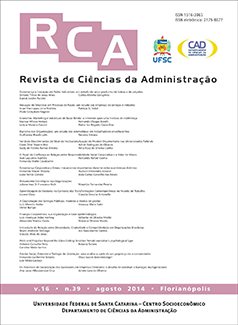Pride and prejudice beyond the glass ceiling: Brazilian female executives´ psychological type
DOI:
https://doi.org/10.5007/2175-8077.2014v16n39p210Resumen
This paper intends to relate characteristics of female executive psychological type with their male colleagues in corporations operating in Brazil (CEOs, VPs/directors and top managers). The theoretical framework explores the glass ceiling and the prejudices faced by female executives. It was developed a mixed qualitative-quantitative method. In the quantitative part we interviewed 743 men and 222 women from 344 corporations. We applied also the questionnaire MBTI to 430 of these executives. In the qualitative part we held focus groups with 227 individuals and 104 semi-structured interviews. The most active psychological MBTI type found was the ESTJ, both to men and women. The dominant characteristics in this type is more rational, logical and less emotional. Prejudices are huge: women need to work harder to show that they are as competent as men. They also live the society's pressure in relation to the roles as mother and wife.
Descargas
Publicado
Cómo citar
Número
Sección
Licencia
El autor deberá garantizar:
- que exista pleno consenso entre todos los coautores para aprobar la versión final del documento y su envío para publicación.
que su trabajo es original, y si se utilizó trabajo y/o palabras de otras personas, estos fueron debidamente reconocidos.
El plagio en todas sus formas constituye un comportamiento editorial poco ético y es inaceptable. RCA se reserva el derecho de utilizar software o cualquier otro método de detección de plagio.
Todos los envíos recibidos para evaluación en la revista RCA pasan por la identificación de plagio y autoplagio. El plagio identificado en los manuscritos durante el proceso de evaluación dará lugar al archivo del envío. Si se identifica plagio en un manuscrito publicado en la revista, el Editor Jefe realizará una investigación preliminar y, de ser necesario, se retractará.
Los autores otorgan a RCA los derechos exclusivos de primera publicación, estando la obra licenciada simultáneamente bajo la Licencia Creative Commons (CC BY) 4.0 Internacional.

Los autores están autorizados a celebrar contratos adicionales por separado, para la distribución no exclusiva de la versión del trabajo publicado en esta revista (por ejemplo, publicación en un repositorio institucional, en un sitio web personal, publicación de una traducción o como capítulo de un libro), con reconocimiento de autoría y publicación inicial en esta revista.
Esta licencia permite a cualquier usuario tener derecho a:
Compartir: copiar, descargar, imprimir o redistribuir el material en cualquier medio o formato.
Adapte: remezcle, transforme y cree a partir del material para cualquier propósito, incluso comercial.
Bajo los siguientes términos:
Atribución: debe dar el crédito apropiado (citar y hacer referencia), proporcionar un enlace a la licencia e indicar si se realizaron cambios. Debe hacerlo bajo cualquier circunstancia razonable, pero de ninguna manera que sugiera que el licenciante lo respalda a usted o su uso.
Sin restricciones adicionales: no puede aplicar términos legales ni medidas tecnológicas que restrinjan legalmente a otros hacer algo que la licencia permite.


